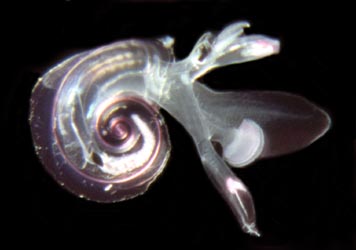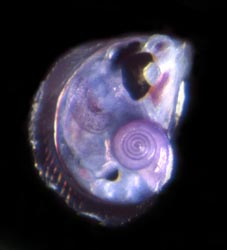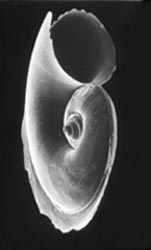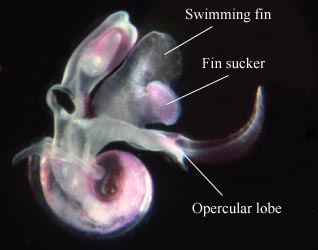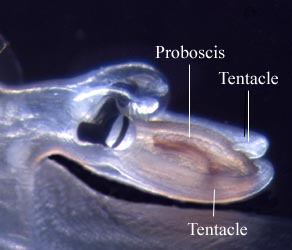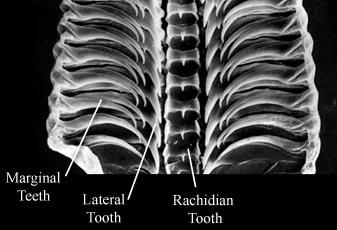Atlantidae
Roger R. Seapy- Atlanta Lesueur, 1817
- Oxygyrus keraudreni
- Protatlanta souleyeti
Introduction
Atlantids are the most species-rich family of heteropods, containing over 60% of all species. They are small (< 1 cm), and their bodies can be retracted entirely into their shells and closed off by a chitinous operculum on the opercular lobe of the foot. The head has a pair of large tentacles anterior to the eyes. A large muscular sucker, located on the posteroventral margin of the swimming fin, is used to hold prey fast while feeding. Atlantids are found primarily between the surface and 200 m in tropical to subtropical waters. Many species undergo vertical migration from daytime depths into shallower waters at night.
Diagnosis
A heteropod with:
- Body retractable into shell.
Characteristics
- Shell
- Body fully retractable into shell.
- Adult shell with dextral (right-hand) coiling and laterally flattened.
- Shell aperture closed with operculum.
- Foot
- Sucker large relative to fin size.
- Opercular lobe and operculum present.
- Head
- Tentacles large and may extend beyond contracted proboscis.
- Each eye elevated above head surface.
- Radula
- Rachidian tooth (central tooth in each tooth row) with one (Atlanta and Protatlanta) or three (Oxygyrus) short cusps.
Figure. Left - Side view of Atlanta helicinoides, with body retracted into shell, Hawaiian waters. Photograph copyright ? 2005 R. Seapy. Right - Frontal view of Atlanta plana shell with slight tilt, diameter 2.1 mm, Hawaiian waters. Scanning electron micrograph copyright ? 2005 R. Seapy.
Figure. Side view of Oxygyrus keraudreni, Hawaiian waters. Operculum, located beneath opercular lobe in photograph, not visible. Photograph copyright ? 2005 R. Seapy.
Figure. Side view of head and proboscis of Atlanta peroni, Hawaiian waters. Photograph copyright ? 2005 R. Seapy.
Figure. Radula of Atlanta californiensis. Scanning electron micrograph copyright ? 2005 G. Richter.
Comments
Most species are in the genus Atlanta; Protatlanta and Oxygyrus are monotypic. Due to the variability in species-level characters in Atlanta, generic differences are few and difficult to use. The genera can be distinguished by the following characters:
| Genus | Shell and keel compositon | Spiral portion of operculum |
|---|---|---|
| Atlanta | Calcareous shell and keel | Present |
| Protatlanta | Calcareous shell and conchiolin* keel | Present |
| Oxygyrus | Conchiolin shell and keel | Absent |
References
Batten, R. L. and M. P. Dumont. 1976. Shell ultrastructure of the Atlantidae (Heteropoda, Mesogastropoda) Oxygyrus and Protatlanta, with comments on Atlanta inclinata. Bull. Amer. Mus. Nat. Hist. 157: 263-310.
Richter, G. 1961. Die Radula der Atlantiden (Heteropoda, Prosobranchia) und ihre Bedeutung für die Systematik und Evolution der Famiie. Morphol. Ökol. Tiere 50: 163-238.
Richter, G. 1974. Die Heteropoden der "Meteor"-Expedition in den Indischen Ozean, 1964/65. "Meteor" Forsch.-Ergebn. (D), 17: 55-78.
Richter, G. and R. R. Seapy. 1999. Heteropoda, pp. 621-647. In: D. Boltovskoy (ed.), South Atlantic Zooplankton. Leiden: Backhuys Publ.
Seapy, R. R. 1990. The pelagic family Atlantidae (Gastropoda: Heteropoda) from Hawaiian waters: a taxonomic survey. Malacologia 32: 107-130.
Seapy, R. R., C. M. Lalli and F. E. Wells. 2003. Heteropoda from western Australian waters, pp.513-546. In: F. E. Wells, D. I. Walker and D. S. Jones (eds.), The marine flora and fauna of Dampier, Western Australia. Perth: Western Australia Museum.
Spoel, S. van der. 1976. Pseudothecosomata, Gymnosomata and Heteropoda (Gastropoda). Utrecht: Bohn, Scheltema & Holkema. 484 pp.
Spoel, S. van der, L. Newman and K. W. Estep. 1997. Pelagic molluscs of the world. World Biodiversity Data Base CD-ROM Series. Amsterdam: Expert Center for Taxonomic Identification (ETI).
Tokioka, T. 1961. The structure of the operculum of the species of Atlantidae (Gastropoda: Heteropoda) as a taxonomic criterion, with records of some pelagic molluscs in the North Pacific. Publ. Seto. Mar. Biol. Lab. 9: 267-332.
About This Page
Correspondence regarding this page should be directed to Roger R. Seapy at
Page copyright © 2005
- First online 16 February 2005
Citing this page:
Seapy, Roger R. . 2005. Atlantidae. Version 16 February 2005 (under construction). http://tolweb.org/Atlantidae/28732/2005.02.16 in The Tree of Life Web Project, http://tolweb.org/





